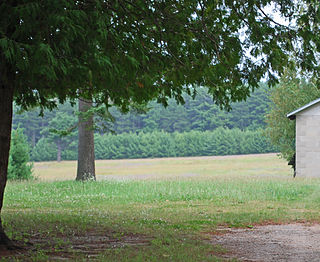
The Onondaga Limestone is a group of hard limestones and dolomites of Devonian age that form an important geographic feature in some areas in which it outcrops; in others, especially its Southern Ontario portion, the formation can be less prominent as a local surface feature.

Fayette Historic State Park is the state park of the historic town of Fayette in the U.S. state of Michigan. It is located on the Big Bay de Noc of Lake Michigan, between Snail Shell Harbor and Sand Bay, on the southern side of the Upper Peninsula, about 17 miles south of US 2. Fayette was the site of an industrial community that manufactured charcoal pig iron between 1867 and 1891. The town has been reconstructed into a living museum, showing what life was like in this town in the late 19th century. It was listed on the National Register of Historic Places in 1970.

Fulacht fiadh is the name given to one of many burned mounds, dating from the Bronze Age, found in Ireland. Most surviving examples consist of a low horseshoe-shaped mound of charcoal-enriched soil, and heat shattered stone, with a cooking pit located in a slight depression at its centre. In ploughed fields, they are apparent as black spreads of earth interspersed with small sharp stones.

The Door Peninsula is a peninsula in eastern Wisconsin, separating the southern part of the Green Bay from Lake Michigan. The peninsula includes northern Kewaunee County, northeastern Brown County, and the mainland portion of Door County. It is on the western side of the Niagara Escarpment. Well known for its cherry and apple orchards, the Door Peninsula is a popular tourism destination. With the 1881 completion of the Sturgeon Bay Ship Canal, the northern half of the peninsula became an island.

This is a list of the National Register of Historic Places listings in Delta County, Michigan.

Lenggong is a town, a mukim and a parliamentary constituency in Hulu Perak District, Perak, Malaysia. The Lenggong valley in Hulu Perak is one of Peninsular Malaysia's most important areas for archaeology, as excavations have revealed many traces of Malaysia's prehistory. It is the site of the oldest known place of human activity in the Peninsula. Today it is still a rural area, with small kampongs surrounded by green vegetation and limestone hills. Lenggong can be likened to an open-air museum, and is home to legends, skeletons, cave drawings and precious finds such as jewellery, pottery, weapons and stone tools. Many of the caves in the Lenggong area have revealed evidence of ancient humans having lived and hunted in this area. The Lenggong Valley was listed by UNESCO as a World Heritage site on 30 June 2012.

The Grand Village of the Illinois, also called Old Kaskaskia Village, is a site significant for being the best documented historic Native American village in the Illinois River valley. It was a large agricultural and trading village of Native Americans of the Illinois confederacy, located on the north bank of the Illinois River near the present town of Utica, Illinois. French explorers Louis Joliet and Father Jacques Marquette came across it in 1673. The Kaskaskia, a tribe of the Illiniwek people lived in the village. It grew rapidly after a French mission and fur trading post were established there in 1675, to a population of about 6,000 people in about 460 houses. Around 1691 the Kaskaskia and other Illiniwek moved further south, abandoning the site due to pressure from an Iroquois invasion from the northeast.

The Garden Peninsula is a peninsula of 22 miles (35 km) in length that extends southwestward into Lake Michigan from the mainland of Michigan's Upper Peninsula. The peninsula is bordered by Lake Michigan on the east, and by Big Bay de Noc on the west. The base of the peninsula is served by U.S. Highway 2, and the peninsula's west shore is reached by M-183. The largest settlement on the peninsula is the village of Garden.

Fort Rock Cave was the site of the earliest evidence of human habitation in the US state of Oregon before the excavation of Paisley Caves. Fort Rock Cave featured numerous well-preserved sagebrush sandals, ranging from 9,000 to 13,000 years old. The cave is located approximately 1.5 miles (2.4 km) west of Fort Rock near Fort Rock State Natural Area in Lake County. Fort Rock Cave was declared a National Historic Landmark in 1961, and added to the National Register of Historic Places in 1966.

The Marmes Rockshelter is an archaeological site first excavated in 1962, near Lyons Ferry Park and the confluence of the Snake and Palouse Rivers, in Franklin County, southeastern Washington. This rockshelter is remarkable in the level of preservation of organic materials, the depth of stratified deposits, and the apparent age of the associated Native American human remains. The site was discovered on the property of Roland Marmes, and was the site of the oldest human remains in North America at that time. In 1966, the site became, along with Chinook Point and the American and English Camps on San Juan Island, the first National Historic Landmarks listed in Washington. In 1969, the site was submerged in water when a levee protecting it from waters rising behind the then newly constructed Lower Monumental Dam, which was 20 miles (32 km) down the Snake River, failed to hold back water that leaked into the protected area through gravel under the soil, creating Lake Herbert G. West.

The Manis Mastodon site is a 2-acre (1 ha) archaeological site on the Olympic Peninsula near Sequim, Washington, United States, discovered in 1977. During the 1977-78 excavation, the remains of an American mastodon were recovered with a 13,800-year-old projectile point made of the bone from a different mastodon embedded in its rib. The site was placed on the National Register of Historic Places in 1978.

The Upper Mississippian cultures were located in the Upper Mississippi basin and Great Lakes region of the American Midwest. They were in existence from approximately A.D. 1000 until the Protohistoric and early Historic periods.

The Plum Island Eagle Sanctuary is a 52-acre island in the Illinois River owned by the Illinois Audubon Society. It was purchased March 24, 2004 to act as a wildlife sanctuary, to protect foraging habitat for wintering bald eagles. It is close to Matthiessen State Park and adjacent to Starved Rock State Park.

The following outline is provided as an overview of and topical guide to the prehistoric people of Colorado, which covers the period of when Native Americans lived in Colorado prior to contact with the Domínguez–Escalante expedition in 1776. People's lifestyles included nomadic hunter-gathering, semi-permanent village dwelling, and residing in pueblos.

The Summer Island site, designated 20DE4, is an archaeological site located on the northwest side of Summer Island, in Delta County, Michigan. It is classified as a stratified, multi-component site with Middle Woodland, Upper Mississippian and Early Historic/Protohistoric occupations. It was listed on the National Register of Historic Places in 1971.

The Skegemog Point Site, also known as the Samels Field Site or Samels Site and designated 20GT2, is an archaeological site located on the property of the Samels Farm at 8298 Skegemog Point Road, near Williamsburg, Michigan. Material at the site spans over 10,000 years, and the site is unique in that, due to glacial rebound, it is horizontally stratified rather than vertically stratified. The site was listed on the National Register of Historic Places in 1972.

The Moccasin Bluff site is an archaeological site located along the Red Bud Trail and the St. Joseph River north of Buchanan, Michigan. It was listed on the National Register of Historic Places in 1977, and has been classified as a multi-component prehistoric site with the major component dating to the Late Woodland/Upper Mississippian period.
The Griesmer site (La-3) is located on the Kankakee River in Lake County, Indiana, about a mile southeast of Schneider, in Northwestern Indiana. It is classified as a Prehistoric, multi-component site with Middle Woodland, Late Woodland and Upper Mississippian occupations. The deposits were not stratified, but observation of the types of artifacts present, together with radiocarbon dates, helped to define the sequence of occupations at the site.
The Oak Forest Site (11Ck-53) is located in Oak Forest, Cook County, Illinois, near the city of Chicago. It is classified as a late prehistoric to Protohistoric/Early Historic site with Upper Mississippian Huber affiliation.
The Anker Site (11Ck-21) is located on the Little Calumet River near Chicago, Illinois. It is classified as a late prehistoric site with Upper Mississippian Huber affiliation.


















